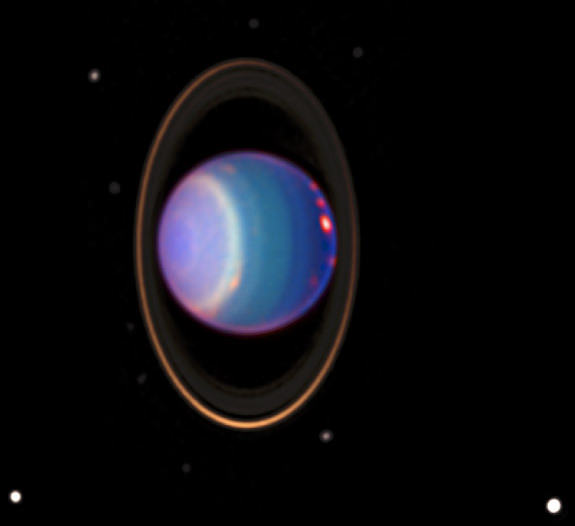Here’s this week’s Where In The Universe Challenge. You know what to do: take a look at this image and see if you can determine where in the universe this image is from; give yourself extra points if you can name the instrument responsible for the image. We’ll provide the image today, but won’t reveal the answer until tomorrow. This gives you a chance to mull over the image and provide your answer/guess in the comment section. Please, no links or extensive explanations of what you think this is — give everyone the chance to guess.
UPDATE: The answer has now been posted below.
This is an infrared image from Hubble of Uranus, taken way back in 1998. The rings really stand out in infrared, so we can see that the planet is surrounded by its four major rings — and if you look closely — by 10 of its 17 known satellites.
Also visible are clouds — about 20 in all, nearly as many clouds on Uranus as the previous total in the history of modern observations. The orange-colored clouds near the prominent bright band circle the planet at more than 300 mph (500 km/h). One of the clouds on the right-hand side is brighter than any other cloud ever seen on Uranus, at least back in 1998.
Credit for this image goes to Erich Karkoschka from the University of Arizona and, of course, NASA. See more about this image at the HubbleSite.
Check back later this week for another WITU challenge!


Neptune
by Hubble??
does Cassini have color capabilities??
Hm… good one. This is either Uranus or Neptune, but I’m going with Uranus here. The photographer was, I believe, the Hubble, in near infrared wavelengths.
Uranus, in false color. Image taken by the NICMOS camera aboard HST, summer 1998.
That’s Uranus, with its faint rings and some its main moons. I just remember Ariel and (almost shattered) Miranda. Taken by Hubble, about ten years ago.
Wow, I knew it was Uranus from Hubble, but not which camera nor the year!
it’s Uranus, you can tell because it’s on it’s side.
though I want to say it’s some kind of composite with Hubble and maybe another scope. though I’m probably wrong.
I have this picture and I would like to say it is Mercury; but if I did then I would be wrong because it is definitely Uranus.
i agree it is Uranus, but not because if appears to be rotating on its side. If the photo were rotated 90 degrees would that make it Neptune?
uranus and if i’m wrong *shakes fist*
Uranus, I think that is the easiest WITU Challenge ever 😀
It is Neptune. The inclination of the poles of the planet are 42-deg, which is seen by the alignment of the pole with the ring.
LC
Oh, C’mon! I thought WITU was a challenge of sorts.
No, not Neptune. It’s that planet with a name that some people think is funny.
It’s obviously Uranus. Taken by Hubble in Near-IR spectrum.
I’ll go for NIRCAM with the Keck AO system, locked on one of the moons!
Its Uranus
Im guessing it was Hubble that took this.
but idk…
So ima add that it was originally called Georgium Sidus…
Back in the day.
Uranus in infrared.
Credit: E. Karkoschka et al. (University of Arizona),
camera NICMOS from Hubble Space Telescope.
Wait I’m changing my answer to :
the Death Star exploding in the “remastered” Star Wars :a New Hope
Definitely Uranus, taken in infrared by Hubble.
Yeah, that’s an easy one — Wikipedia confirms it!
(No, I will not say what it definitely is, nor provide a link!)
Too easy. Uranus in false colour. Voyager 2 is the only probe to have been there but my memory says it din’t detect the rings as clearly as this, so I’m going with Hubble.
Uranus in false-colour taken by Hubble’s NICMOS on 8th August 1998.
Uranus, in infrared or something.
Of course it’s Uranus, a Hubble Space Telescope image.
I agree it looks like Uranus, but the red spots look like the impact of comet shoemaker levy 9 on Jupiter taken by some probe out Saturns way, I know the Casini probe is there
The fabled “rings around Uranus” – the bane of astronomy teachers everywhere. We’re asked about ’em every year by students only to endure the predicted laughter. And there they are!
The effects of global warming on Uranus.
Not “everywhere”, neoguru.
Around here, Urano, our name for the planet, has no laughable connotations. With or without the rings attached… 😉
Hey, here’s a thought: start calling it Urano, as we do. Problem solved! 😉
Uranus surrounded by its four major rings and by 10 of its 17 known satellites. This false-color image was generated by Erich Karkoschka using data taken on August 8, 1998, with Hubble’s Near Infrared Camera and Multi-Object Spectrometer.